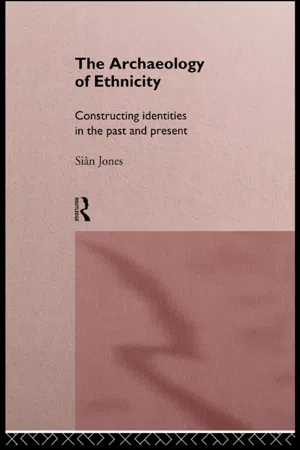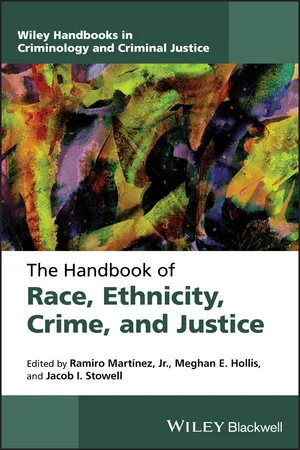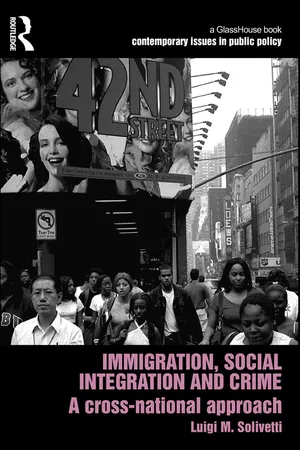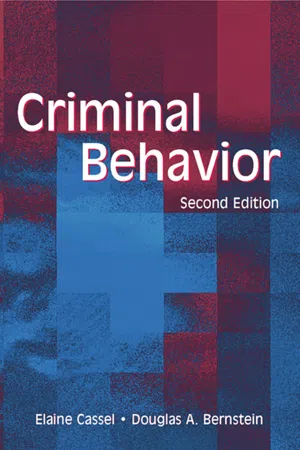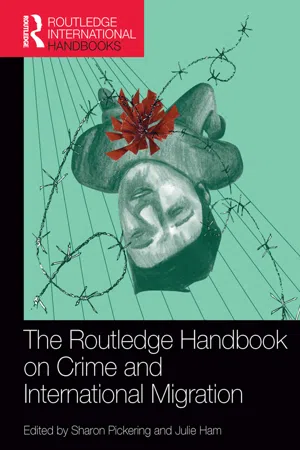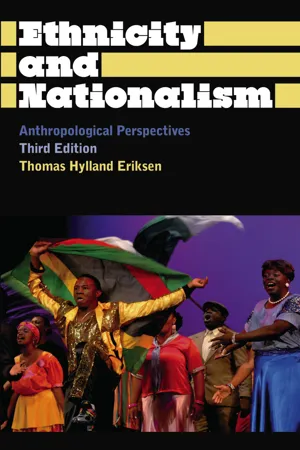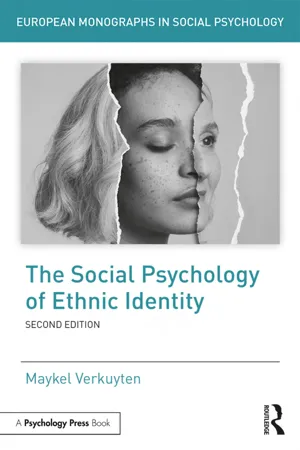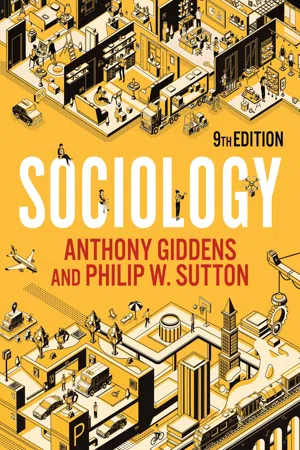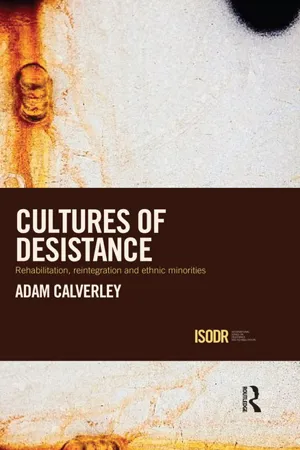Social Sciences
Ethnicity and Crime
Ethnicity and crime refers to the relationship between a person's ethnic background and their involvement in criminal activities. It explores how factors such as discrimination, socioeconomic status, and cultural influences may contribute to variations in crime rates among different ethnic groups. Research in this area aims to understand the complex interplay of social, economic, and cultural factors in shaping patterns of criminal behavior within diverse communities.
Written by Perlego with AI-assistance
Related key terms
Related key terms
1 of 4
Related key terms
1 of 3
10 Key excerpts on "Ethnicity and Crime"
- eBook - ePub
The Archaeology of Ethnicity
Constructing Identities in the Past and Present
- Siân Jones(Author)
- 2002(Publication Date)
- Routledge(Publisher)
Chapter 4EthnicityThe conceptual and theoretical terrain
THE CONCEPTUALIZATION OF ETHNICITY
The prolific use of the term ethnicity to refer to diverse socio-cultural phenomena in the last two to three decades has resulted in considerable disagreement about the nature of ethnic groups. What is ethnicity, and how should it be defined? In the human sciences, definitions of ethnicity have been influenced by a variety of factors which intersect with one another. These include:- the impact of different theoretical and disciplinary traditions (such as neo-Marxism or phenomenology, psychology or anthropology);
- the particular aspects of ethnicity being researched (ranging from the socio-structural dimensions of ethnicity in a plural society, to the cultural construction of ethnic difference, to the effects of ethnic identity on individual performance in education, and so on);
- the region of the world where research is being conducted (e.g. the highlands of Papua New Guinea, American inner cities, the former Soviet Union);
- the particular group that is the subject of research (e.g. the Australian Aborigines, migrant Turkish workers in Europe, or the Jewish people (see Bentley 1983; Isajiw 1974)).
This picture is further complicated by the fact that few people explicitly define what they mean by the terms ethnicity and ethnic group. In a survey of sixty-five sociological and anthropological studies of ethnicity, Isajiw (1974:111) found only thirteen that included some kind of definition of ethnicity, and the remaining fifty-two had no explicit definition at all. However, despite the distinct lack of explicit definitions of ethnicity in much of the literature, it is possible to identify two central issues which cross-cut different conceptualizations of ethnicity: - Ramiro Martinez, Meghan E. Hollis, Jacob I. Stowell, Ramiro Martinez, Meghan E. Hollis, Jacob I. Stowell(Authors)
- 2018(Publication Date)
- Wiley-Blackwell(Publisher)
2014 ) to better understand how these dynamics build and change over time in local communities.Concerns with the Reemergence of Biological and Biosocial Theoretical Approaches to Explain the Race/Ethnicity–Crime Relationship
While social‐structural theories, such as social disorganization theory, focus on the social‐structural explanations for criminal behavior, micro‐level criminological theories examine individual‐level explanations for criminal behavior. This counterpoint to the preceding discussion highlights an area where criminological research must proceed with caution. Much of this work is derived from the early biological and psychological criminology approaches used to explain genetic or psychosomatic predispositions to criminality. The reemergence of biological, biosocial, and biopsychosocial theoretical approaches in recent years warrants a discussion of these contemporary theoretical approaches. This is particularly true given the recent use of these approaches to explain ethno‐racial differences in individual criminality.Biological, psychological, and biosocial theories, and the more recent emergence of biopsychosocial theories, warrant discussion here due to the manner in which they address race and ethnicity. These approaches have received increased attention in recent years (e.g., Boutwell, Nedelec, Lewis, Barnes, & Beaver, 2015 ; Gato, Posick, Williams, & Mays, 2017 ; Rafter, Posick, & Rocque, 2016 ; Rocque & Posick, 2017 ; Rocque, Posick, & Felix, 2015 ). These theories attempt to explain crime through individual biological characteristics, psychological traits, the intersection of biological and social influence, and, more recently, combinations of biological, psychological, and social influences. Some work has traveled into the “natural sciences” to consider biochemical influences on criminality (see, e.g., Gato et al., 2017- eBook - ePub
- Luigi Solivetti(Author)
- 2010(Publication Date)
- Routledge-Cavendish(Publisher)
Social disorganization theory is especially linked with the urban studies conducted by Shaw and McKay (1942), who emphasized the so-called ecological dimension of crime. These studies showed that the rates of criminality of immigrants were influenced by the aspects of disorganization of the quarters of the city in which they lived, aspects such as the rapid turnover of population, its heterogeneity and deracination, rather than by cultural differences and by levels of poverty. In other words, the impact of immigration on crime rates was indirect: it was environmentally conditioned. Immigration conduced to social disorganization, and this in turn increased the crime rate. The high level of criminality was allegedly the consequence of an ‘ecological context’ incapable of exerting sufficient control on the conduct of residents precisely as a result of social disorganization. Under the influence of the forces of social disintegration resulting from these contexts, the community ceases to exist as an agency of social control and criminal behaviour becomes not only tolerated but even at times accepted (Morris 1958). In a context of generalized social disorganization, individuals belonging to different ethnic groups and different cultures will tend to have similar rates of criminality; whereas persons belonging to the same ethnic and cultural group will present very different rates of criminality if resident in quarters with varying levels of social organization. In this context, poverty is a relevant factor in determining the quarter in which a person lives, but assuming that poverty has a direct link with crime would be mistaken.After the Second World War, this theory in its wider ramifications inspired some studies in Europe on degraded urban contexts (Morris 1958) and on the role of immigration on disorganization (Wallis and Maliphant 1967). Yet it has been progressively abandoned, also because the phenomenon of mass immigration, like that registered in the USA at the start of the twentieth century, appeared obsolete.More recently, there has been a revival of ecological studies in the USA, but in a perspective only partially coinciding with the previous one. These new ecological studies revolve around the thesis of so-called ‘racial invariance’. They reject the thesis of an ethnic or racial root of crime, and emphasize instead that race and ethnicity represent factors of a particular propensity to crime only in so far as they are associated with specific social contexts (Sampson and Wilson 1995). These contexts are characterized by pronounced anonymity, weak inter-generational bonds, low levels of social participation and consequently lack of shared values: hence cultural disorganization and in particular the spread of subcultural values that may lead to attitudes of cultural indifference or attitudes favourable to criminality.As may be inferred from what has just been said, this new current of ecological studies is interested not so much in the criminality of immigrants as in that of the slums of North American cities. These inhabitants indeed consist in large part of ethnic minorities, but minorities that are in large part native - eBook - ePub
- Elaine Cassel, Douglas A. Bernstein(Authors)
- 2007(Publication Date)
- Psychology Press(Publisher)
These and other factors are probably at work in yet another form of fan violence that occurs between parents of children involved in competitive sports. In July 2002, Thomas Junta was watching his son’s hockey team practice when he exchanged words with the coach, Michael Costa (the father of a player), about the amount of violence among the players. Costa died of injuries sustained when the men got violent with each other. Junta was sentenced to 6 to 10 years in prison. In Canada in January 2005, a father reached over the glass separating the bleachers from the ice rink and began choking the coach. Spectators broke up the fight before the coach lost his life. Parent and coach interpersonal violence has gotten so bad—and so common—that children’s sports teams now routinely adopt strict rules governing parental misbehavior.Ecology, Ethnicity, and Crime
Sports-related violence is but one example of how social and environmental factors can converge to incline some people toward criminal behavior. The ecological approach to criminal behavior helps explain why criminals may be rich or poor, Black or White, gay or straight, or possessed of virtually any other set of attributes. However, anyone who is unfortunate enough to grow up in an ecological niche that strongly supports criminal behavior is at particular risk for engaging in such behavior. Further, if people who live in such circumstances share the same socioeconomic status, ethnicity, or other demographic characteristics, those characteristics will be especially frequent in the criminal population.People from some ethnic backgrounds are indeed more likely than others to be exposed to a crime-risky ecology and are therefore more likely to be criminals. Members of certain ethnic minority groups, in particular, are involved in a disproportionate amount of crime in the United States. For example, although Blacks make up only about 13% of the general population, they represented 28% of all arrests for FBI Index offenses in 2000 (FBI, 2001 ). Of all those arrested for violent crimes in 2002, 40% were Blacks or Hispanic Americans (FBI, 2003 ). Part of this difference in ethnic representation among arrestees may be due to discriminatory law enforcement practices, but even when this factor is taken into account, Blacks do commit proportionally more crimes than Whites or other ethnic minorities (Currie & Sternbach, 1987 ; Silberman, 1979 ; Tonry, 1996 ; Wilson & Herrnstein, 1985 - Sharon Pickering, Julie Ham, Sharon Pickering, Julie Ham(Authors)
- 2017(Publication Date)
- Routledge(Publisher)
Wickes et al. 2013b ).Social and cultural properties of the immigration-crime link: a longitudinal approach
The immigration revitalization theory states that co-ethnics living in ethnic enclaves develop strong social networks. Over time, these networks provide access to social and economic opportunities. They also provide a strong foundation for the informal social control necessary to regulate crime. This is turn revitalizes the neighbourhood. This thesis strongly resonates with longitudinal studies of immigration and crime in the US, where the clear pattern emerging from the literature is that increasing immigration results in lower crime under most conditions. But there are two problems here. First, few studies actually test the mediating effects of these social processes on crime in these ethnic enclaves. And evidence from the UK indicates that social networks and interaction in immigrant neighbourhoods are not heightened when compared with those of other neighbourhoods (Bell and Machin 2013 ). Second, the broader social science literature provides limited evidence that increasing immigration enhances the social mechanisms associated with the regulation of crime and disorder. Although social processes, like collective efficacy, mediate the effects of the structural characteristics of neighbourhood on crime (Sampson, Raudenbush and Earls 1997 ; Sampson and Wikstrom 2007 ; Mazerolle, Wickes and McBroom 2010 ), there is strong evidence that increasing diversity (and, by implication, immigration) negatively influences these important processes associated with the regulation of crime. For example, in Chicago child-centred informal social control is lower in areas with higher concentrations of immigrants (Sampson, Morenoff and Earls 1999- eBook - ePub
- Tim Newburn(Author)
- 2017(Publication Date)
- Routledge(Publisher)
A stress on difference is unsustainable and will not win support from majority groups who perceive their own identity to be threatened. Thomas’s empirical study of community cohesion and young people’s identity in Oldham, Rochdale and Manchester is from the point of view of their understanding and practice of community cohesion on the ground. Although community cohesion as a policy, when narrowly understood and implemented, has been harmful to Muslim identity, Muslim young people are clearly positive about both British identity and ethnic diversity. If white working-class young people are less positive about diversity, it is argued that this is because of what they see as an exclusive focus on visible minorities rather than on what young people have in common. Ethnicity and offending A long-standing and contentious area in criminology concerns the nature of offending by people of different ethnic origins. Are white people more likely to commit certain types of crime than people of other ethnic origins? Are people of particular origins associated with particular types of crime? If so, why? Is there any basis in reality for our assumptions in this area, and what do assumptions, common portrayals or understandings tell us about ethnic relations and criminal justice? Bowling and Phillips (2002: 78) quote a government report from 1972 which expressed the official view at the time. It stated, ‘coloured immigrants are no more involved in crime than others; nor are they generally more concerned in violence, prostitution and drugs. The West Indian crime rate is much the same as that of the indigenous population. The Asian crime rate is very much lower.’ However, within a relatively short period, some important opinions, not least those of the police, appeared to take a very different view and public concerns about crime associated with minorities seemed to grow relatively quickly - eBook - ePub
Ethnicity and Nationalism
Anthropological Perspectives
- Thomas Hylland Eriksen(Author)
- 2010(Publication Date)
- Pluto Press(Publisher)
1 What is Ethnicity?It takes at least two somethings to create a difference ... Clearly each alone is – for the mind and perception – a non-entity, a non-being. Not different from being, and not different from non-being. An unknowable, a Ding an sich, a sound from one hand clapping.Gregory Bateson (1979: 78)Words like ‘ethnic groups’, ‘ethnicity’ and ‘ethnic conflict’ have become common terms in the English language, and they keep cropping up in the press, in TV news, in political discourse and in casual conversations. The same can be said for ‘nation’ and ‘nationalism’, and it has to be conceded that the meaning of these terms frequently seems ambiguous and vague.There has been a parallel development in the social sciences. In the last few decades, there has been an explosion in the growth of scholarly publications on ethnicity and nationalism, particularly in the fields of political science, history, cultural studies, sociology and social anthropology. This growth is probably only paralleled by the explosion in studies featuring the terms ‘globalisation’, ‘identity’ and ‘modernity’, which incidentally refer to phenomena closely related to ethnicity and nationalism. The relationship of ethnicity to other forms of collective identification, including gender, local and religious identity, will be discussed in the final chapters of this book.In social and cultural anthropology, ethnicity has been a main preoccupation since the late 1960s, and it remains a central focus for research today. Although I hope the relevance of this book extends beyond the confines of academic anthropology, it is built around the contributions of anthropology to the study of ethnicity and kindred phenomena. Through its dependence on long-term fieldwork and its bottom-up perspective on social life, anthropology has the advantage of generating first-hand knowledge of social life at the level of everyday interaction. To a great extent, this is the locus where ethnicity is created and re-created. Ethnic relations emerge and are made relevant through social situations and encounters, and through people’s ways of coping with the demands and challenges of life. From its vantage point right at the centre of local life, social anthropology is in a unique position to investigate these processes at the micro level, although it needs to be supplemented by other approaches such as history and macrosociology in order to develop a full picture of ethnicity and nationalism. - eBook - ePub
- Maykel Verkuyten(Author)
- 2018(Publication Date)
- Routledge(Publisher)
p.46 2 ETHNICITYIn anthropology, ethnicity has been a major research focus since the 1960s and has remained so to the present day. A wide variety of cases, groups and circumstances have come under examination, such as ethnic conflicts, ethnic movements, ethnic entrepreneurs, multi-ethnic neighbourhoods and schools, indigenous populations, and (undocumented) immigrants and refugees. Despite the obvious and important differences between these situations, an ethnic framework is considered useful for understanding (parts of) what is going on. This raises the question of the conceptualization of ethnicity, also because the term has become popular in everyday discourse. ‘The whole conception of ethnic groups is so complex and so vague that it might be good to abandon it altogether’, said Max Weber (1968 [1922], p. 385), illustrating the elusive quality of ethnicity. Although Weber was not enthusiastic about the concept, he actually did not abandon it, but rather tried to give a precise definition that, subsequently, has been adopted by many scholars.How can ethnicity be conceptualized? What is the relationship with culture? What is the difference between ethnicity and race, religion and nationality? How do ethnic distinctions function? And why is ethnicity so important in many instances? All of these questions, among others, are addressed in the anthropological literature. However, I will not give an overview of this literature, as this would lead away from the intention of this book.1 - eBook - ePub
- Anthony Giddens, Philip W. Sutton(Authors)
- 2021(Publication Date)
- Polity(Publisher)
Yet the political and media focus on young black males without this wider contextualization has served to generate recurring moral panics that simplistically link race and crime. The theory of moral panics is discussed in chapter 22, ‘Crime and Deviance’. Ethnic diversity, integration and conflict Many states in the world today are characterized by multi-ethnic populations. Some Middle Eastern and Central European states, such as Turkey or Hungary, are ethnically diverse as a result of long histories of changing borders, occupations by foreign powers and regional migration. Other societies have become multi-ethnic more rapidly, as a result of policies encouraging migration or through colonialism and imperialism. In an age of globalization and rapid social change, international migration is accelerating, and the movement and mixing of human populations seems sure to intensify in the future. Meanwhile, ethnic tensions and conflicts continue to flare up in societies around the world, threatening the disintegration of some multi-ethnic states and protracted violence in others. Ethnic diversity The UK is today an ethnically diverse society. This diversity is an increasingly common feature of most industrialized societies and is key to understanding the policy of multiculturalism, which some governments have adopted to ensure that minority ethnic groups can enjoy the full benefits of citizenship. The population of England and Wales has become gradually more diverse, and around 14 per cent identified themselves as ‘non-white’ in the 2011 census (see figure 8.3). The 1991 census reported 94.1 per cent of the population identified themselves as being in the white ethnic group, but this fell to 91.3 per cent in 2001 and, again, to 86 per cent in 2011 - eBook - ePub
Cultures of Desistance
Rehabilitation, Reintegration and Ethnic Minorities
- Adam Calverley(Author)
- 2012(Publication Date)
- Routledge(Publisher)
Representations of Asians’ involvement in criminal behaviour have also been constructed upon a racialised discourse that frames its causes as different to those of white criminality. Depictions of Asian deviance and the meanings attributed to it have changed over time, like the racist discourse found in discussions of Black people and crime, but these have taken on different characteristics (Bowling and Phillips: 2002, 79-82). A notable feature of discussions of Asian criminality in the 1970s and 1980s was the association of Asian with low levels of offending, attributed in early studies to cultural constraints of conformity and strengths of informal social controls within extended family (Mawby and Batta cited in Bowling and Phillips, 2002:80). Partly as a response to racist violence, the 1990s witnessed a shift in Asian masculine representations in association with crime from Asian men being seen as passive ‘avoiders’ to one where they were ‘increasingly labelled aggressors’ (Goodey, 2001, 446; Webster, 1997). A new ‘folk devil’ of young Asian men is said to have emerged (Alexander, 2000). The combination of supposed pathological involvement in urban crime outside the constraints of traditional ‘communities’, the riots of 2001 in Northern towns (Webster, 2004; Alexander, 2004), and the post-September 11 climate of Islamophobia and fear of terrorism have all combined to construct young Asian male Muslims as a supposed cultural and national threat to security; one that informs processes of criminalisation and labelling.Thus there exists a substantial body of evidence concerning ethnicity in relation to engagement in offending behaviour. Interpreting what this evidence means has focused on the issue of disproportionality of certain ethnic groups within the official crime statistics and the contentious debate surrounding what factors are responsible for this phenomenon. However, this research literature has largely ignored the issue of disengagement
Index pages curate the most relevant extracts from our library of academic textbooks. They’ve been created using an in-house natural language model (NLM), each adding context and meaning to key research topics.
Explore more topic indexes
Explore more topic indexes
1 of 6
Explore more topic indexes
1 of 4
